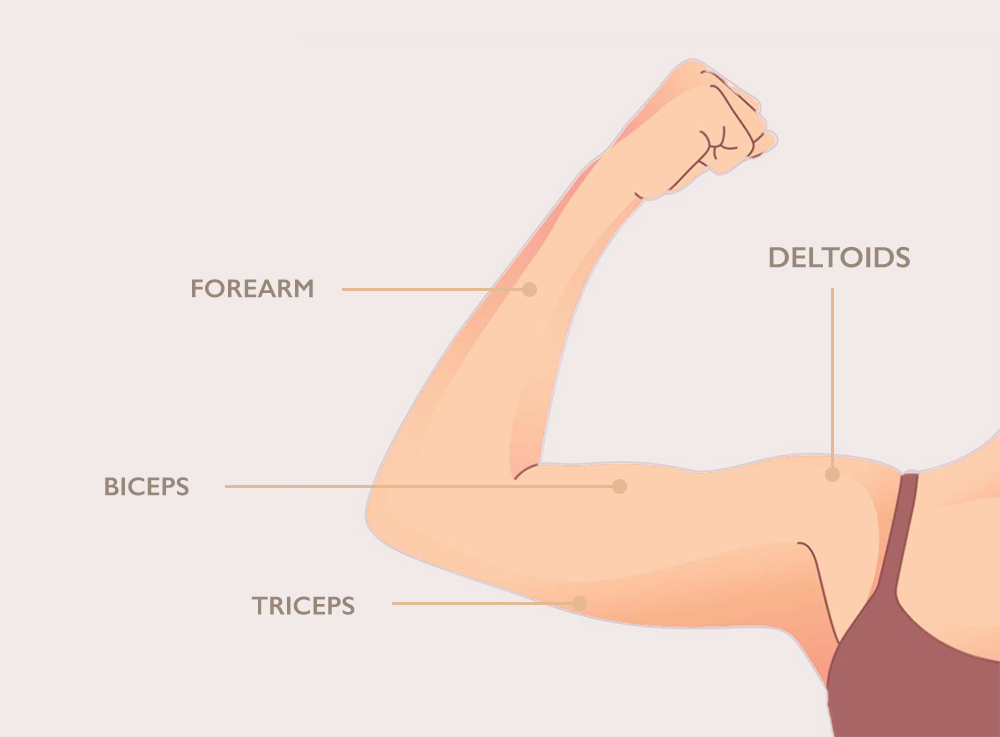When working the arm muscles, make sure to target the different parts of the arms. Here’s a simple breakdown of the arm muscles that you’ll want to target.
<< Spotlight >>
Sculpting and strengthening your arms comes with a host of benefits, including making everyday tasks easier such carrying a bag of groceries, holding a yoga pose, or improving athletic performance in sports that require throwing or hitting a ball. Plus the arms are always on show. T-shirt, tank top, or sleeveless dress. While the abs may get a lot of attention come the summer months, the arms never go out of season.
Arm Anatomy
The arms consist of four major muscles groups.
Biceps. The biceps is a thick muscle located at the front of your upper arm and gives the arms a lot of shape. Strengthening the biceps tones and shapes the front of arms. The biceps is split in two at the top (it has two heads) and joins together in the middle to make a large muscle belly before tapering at the bottom near the elbow. The main function of the biceps is to flex the arm at the elbow joint (bring the upper and lower arm closer together) and supinate the forearm (turn your hand from palm-down to palm-up).
Triceps. The triceps is located on the back and the outside of the arm. It is actually larger than the biceps and consists of 3 heads that join together. Targeting the triceps tones and tightens the back of the arms. This is an area people often complain is flabby and jiggles when they wave, and which they want to tone and tighten. The triceps is responsible for extending (straightening) your arm at the elbow joint.
Forearm. This muscle group is often forgotten, but all arm exercises also target this area. Strengthening the forearm helps prevent muscle imbalances and improves grip strength, which helps with everyday movements such as opening a jam jar or carrying something heavy.
Deltoids. The shoulder muscle, or deltoid to be exact, makes up the top of the arm and gives the shoulder its rounded contour. Many exercises that work the biceps and triceps also target this muscle. The function of the deltoid muscle is to rotate the arm and to move the upper arm outward, away from the body (abduction). It also stabilizes the shoulder joint.

Main Types of Arm Exercises
A well-balanced workout routine should include different types of arm exercises. Arm exercises can be divided into 4 categories. Include exercises from each category to target your arms from every angle.
Arm Exercise Library
Arm Up
Arm Exercise Tips
To get the most out of your arm workouts, remember the following points:
Do not lock your elbows. When you lock your elbows it causes the wrists and shoulders to lock too. Hyperextending the arms, especially while lifting weight (including body weight), increases the risk of injury. To get the most benefit when performing arm exercises use your elbows’ full range of motion, but without forcing your arms into a locked position.
Pay attention to exercise form. It’s common for shoulders to slump forward or hunch up towards the ears. This puts the shoulders in a vulnerable position when lifting weights. To prevent poor posture make sure your chest and shoulders are open. To help with this, every few moves shrug your shoulders downward and roll them back to reset your form.
Choose the right weight. Choose a weight that allows you maintain proper form but is heavy enough to challenge you. For example, if you are performing 8 to 12 reps of an arm exercise, the last two reps in each set should be difficult to finish, while still maintaining good form. However, if you start using other muscles to help lift the weight, use momentum, or otherwise change your form choose a lighter weight.
The best place to find a helping hand is at the end of your own arm.

